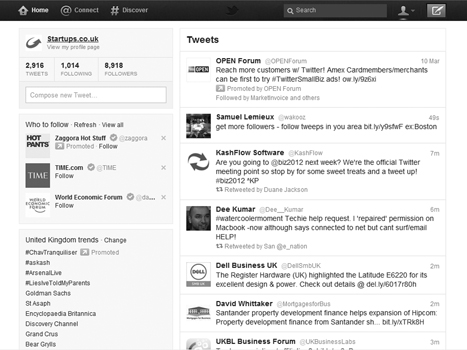How They Started (18 page)
Authors: David Lester

Despite this, the founders resisted the idea of simply slapping ads on the site and searched for less-obnoxious revenue ideas. Meanwhile, big companies began experimenting with Twitter. In 2008, Dell reported it had made $1 million selling reconditioned computers from its outlet store by offering discount coupons on Twitter. Cable giant Comcast overhauled its poor customer-service reputation with its Twitter account @ComcastCares, which responded quickly to customer complaints.
At the same time, other entrepreneurs were building businesses on Twitter’s back. The company’s open source platform let developers use Twitter’s code to create related services. Hundreds of thousands of Twitter apps would be built, including the Twitter scheduler Tweetdeck, which became so popular that Twitter would later acquire it for $40 million.
Some users tried out new personas on Twitter. A few were so amusing, they ended up with publishing and public-speaking deals. Two standouts were Fake Steve Jobs and Fake AP Stylebook.
Cable giant Comcast overhauled its poor reputation with its Twitter account @ComcastCares, which responded quickly to customer complaints.
Aside from the obvious fakery of Fake Steve Jobs, however, Twitter had a big problem with covert imitators. As celebrities and prominent politicians began to show an interest in Twitter, other users were setting up accounts, pretending to be a popular film actor or rock musician, and sending out messages that embarrassed the star. To encourage celebrity participation and eliminate these spoofers, Twitter created a Verified Accounts program.
One late-2007 adopter was then-presidential hopeful Barack Obama, who cannily used social media to rally voters. In 2009, Oprah, Lady Gaga and Ashton Kutcher joined, with Kutcher becoming the first person to gain a million Twitter followers. The celebrities were a promotional bonanza for Twitter—each drawing press coverage and masses of followers, many of whom joined to connect with their idol. Oprah created a 43 percent traffic spike when she joined live on her talk show in April 2009.
The celebrity sparkle helped skyrocket Twitter’s audience to five million users by the end of 2008, and to over 71 million in 2009. With just 50 employees in 2008, Twitter struggled to keep up.
“It’s like we’re on a rocket ship that we’re just painting and suddenly it took off and we’re holding on to the ship with our fingernails,” Biz told the
New York Times
.
Institutional investors including T. Rowe Price and Morgan Stanley put another $135 million into the company in 2009, at a reported valuation of $1 billion. The financial support bought Twitter more time to explore non-intrusive ways of earning revenue from its mushrooming audience.
Users delighted in announcing their trivial activities on Twitter. But the founders always imagined Twitter would have a higher purpose of connecting people around the world to promote good causes.
In April 2008, Twitter fulfilled that purpose. When University of California at Berkeley student James Buckley was arrested while photographing protests in Egypt, his call for help was a single-word tweet: “Arrested.” His 48 followers quickly contacted the US Embassy and the press. Buckley was soon able to tweet, “Free.”
In natural disasters, too, Twitter proved invaluable. When an earthquake hit China in May 2008, Twitter became the go-to news source for early disaster reports, as users on the scene tweeted information from cellphones. Reporters used the tweets in their stories, and charities joined in with Twitter-based fundraising appeals.
Twitter became an essential tool for political activists. This was brought home during Iranian protests in June 2009, when the US State Department asked Twitter to postpone scheduled maintenance that might take the service offline.
In late 2010, the Middle East began to erupt in anti-government protests that became known as “Arab Spring,” and as oppressive regimes in Tunisia and Egypt toppled, political observers credited Twitter with playing a supporting role. In perhaps the ultimate demonstration of Twitter’s importance, Egypt shut down Internet access in January 2011 to prevent protesters from using Twitter.

A screenshot of a Twitter news feed.
As Twitter struggled to find a way to earn revenue, its leadership changed repeatedly. Evan had taken the reins from Jack in 2008, while Jack left to found the mobile-payments startup Square.
In fall 2009 Evan brought on investor and friend Dick Costolo as chief operating officer. When Evan stepped down as CEO in October 2010, Costolo became the new CEO. In January 2010, Kleiner Perkins Caufield & Byers added a $200 million investment to Twitter’s pot.
After some testing in late 2009 with half a dozen corporate advertisers, several revenue-generating programs officially debuted in summer 2010. Companies could buy “promoted” tweets—at $100,000 a day—and hashtagged “trending” topics. (If a promoted tweet isn’t clicked on, a “resonance algorithm” detects this and removes it from view.) Local ads were announced as a coming option, but at the end of 2011 had yet to materialize.
Twitter reports that its promoted tweets get click rates of 3–5 percent, which is roughly 100 times better than typical click-through rates for online ads. In 2011, promoted tweets began appearing at the top of users’ search results.
Where are they now?
In early 2011, Jack returned to Twitter as executive chairman while continuing as CEO at Square. Evan left Twitter, and Biz would follow Evan out the door to the re-formed Obvious Corp. For his part, Noah Glass’s Twitter bio reads, “i started this.”
In November 2011, Twitter had more than 100 million monthly users and 250 million tweets were posted daily. The company’s valuation was estimated at up to $10 billion. Hiring finally sped up in 2011, with 500 new hires added for 800 employees total (100 of them in ad sales). Most notably, 2,400 companies were advertising on Twitter. One success story: Paramount Pictures estimated that in a couple of hours on Twitter it sold $1.5 million in tickets for the opening day of its film
Super 8
.
Internet-research firm eMarketer estimated Twitter would see $50 million in 2011 revenue and $250 million in 2012—substantial income to be sure, but not yet a figure that justifies the level of investment funding Twitter has accepted. Is there more potential ahead?
“We’ve only achieved 1 percent of what Twitter can be,” Costolo says.
Will Twitter go public or be sold? The huge amount of venture capital invested—including a mammoth $800 million funding round in 2011—means a cash-generating event will likely come soon. Both Facebook and Google are rumored to have made offers.

Discovering treasure on its travels
Founder:
Stephen Kaufer
Age of founder:
38
Background:
Degree in computer science from Harvard University
Founded in:
2000
Headquarters:
Newton, Massachusetts
Business type:
Travel reviews website

TripAdvisor’s 60 million-plus user reviews
are some of the most widely read hotel and restaurant assessments in the world. The site draws more than 50 million unique visitors each month and ranks among the world’s most trafficked websites. Just over a decade ago, however, TripAdvisor was on the verge of going bust.
A true innovator, the company rode out the storm and led where others tried and failed, building a “movement”—a thriving community that has nearly eclipsed the company itself. Waving the banner of “citizen tourism,” the company attracts millions daily to its more than 50 million travel reviews. It boasts eight million photos from its members’ travels, and a staggering 98 percent of new topics in its lively forums are replied to within 24 hours. People cannot stay away.
In 1999, Stephen Kaufer just wanted to take a vacation. He and his wife were trying to plan a trip to Mexico, and, on the recommendation of a local travel agency, they went online to check out a few resorts. It was easy enough to find the glossy brochures and guidebooks, he says, but what he really wanted were first-hand opinions from those who had been there. Instead, at every website they visited, they found that the photos and descriptions of each resort were the same.
Stephen was frustrated. It was the height of the dot-com boom, but the principles of Web 2.0 had yet to take hold. Stephen just wanted an honest opinion of each resort, but all he could find in his fruitless Web searching was an endless loop of the same recycled promotional material. Eventually he found someone’s personal home page that featured a few candid photos from one of the resorts and a paragraph about its facilities. He then realized that if the reality of this resort was quite different from its brochure, then it was probably the same for many more.
“Each time we were recommended a destination and hotel, I’d go online and search high and low to find more information, and each time, we’d find a problem—the hotel wasn’t up to par, the destination was unsafe, etc,” he says. “It took an enormous amount of time to research these places properly, and it was through these endless searches that the TripAdvisor concept was born—I wanted a single place where I could get the real scoop on a hotel, not just the official blurb from the property or a travel agent.”
Stephen has always been an entrepreneur at heart. He co-founded his first business, a software development tool company, in 1984 while pursuing his computer science degree at Harvard. That company was eventually sold off in 1998, but, just a year later, Stephen’s experience trying to book a hotel had him again thinking entrepreneurially. He said to himself that there had to be a better way to plan a vacation online. Soon after, in February 2000, TripAdvisor appeared.
“I was employed at the time, so I put the idea on hold for about a year and then started gathering a group of people who I thought would be interested in creating what would become TripAdvisor,” Stephen says. “In 2000 we were up and running, albeit in a different way than we do now.”
The company actually began life as a search engine. These were the days when sites like Lycos, Go and Excite were the most visited pages on the Web, and an upstart Google was making a fast name for itself with its authoritative search results. These were Stephen’s models, but approached from the opposite angle. Rather than trying to rank results based on their perceived worth, TripAdvisor simply provided unfiltered links to any travel reviews on the Web. Stephen’s aim was to unearth the raw, candid opinions of services and popular destinations in the travel industry—the opinions that lurked on personal Web pages in the furthest reaches of the Internet. Except it didn’t work.
